Sonos Radio

When it comes to home audio, unless you want to build out a full setup of individual components yourself (and spend thousands of dollars), Sonos has some of the best options on the market. Their…

When it comes to home audio, unless you want to build out a full setup of individual components yourself (and spend thousands of dollars), Sonos has some of the best options on the market. Their…
The Sonos Move ($399) represents a bunch of “firsts” for Sonos. It’s the company’s first Bluetooth speaker, its first portable speaker and, thus, its first speaker to have a built-in battery (which Sonos had to build from scratch). Unlike all other Sonos speakers before it, the Move is designed to be listened to in, around and outside the home. And if you’re wondering, yes, the Move is weatherproof and drop-resistant, making it Sonos’s first truly rugged speaker, too.
Of course, the Move is still a Sonos speaker and it’s designed to work as such. It can connect to your home’s Wi-Fi network and, via the Sonos app, be grouped with other Sonos speakers in a multi-room system. It’s also a smart speaker, just like the Sonos One, so you can speak to Amazon’s Alexa or Google Assistant and request a song, adjust the volume or ask about the weather.
There are a couple of big questions surrounding the Move. In terms of sound quality, how does it compare to other Sonos speakers? And how should the Move be used? Is it more of a traditional Sonos speaker that, instead of being tethered to the wall, can be carried from room to room? Or is it more a portable Bluetooth speaker, designed to be listened to outside?
The biggest question, at least for me, has to do with the “Sonos experience.” The audio company is so beloved because its speakers sound great and work with almost every music streaming service, but, most importantly, they’re easy enough for anybody to use. So the fact that the Move can be constantly be moved around, switched between Wi-Fi and Bluetooth modes – does that negatively impact that Sonos experience?
The Good: The Sonos Move has that “Sonos sound” – it sounds warm, lively and punchy, both inside and outside, just as you’d expect from a Sonos speaker. Sonos specially designed it with a downward-firing tweeter and forward-firing woofer, and the result is that the Move has more of a 360-dree sound than any other speaker. (Fun fact: even though the Play:1 and Sonos One speakers have a dotted grill the wraps sound most of the speaker, both are still forward-firing and not omnidirectional speakers.) In terms of sound quality and power, the Sonos Move sounds more closely to the Sonos One ($199) rather than the larger and more expensive Play:5 ($499); but it’s definitely in-between the two.
The other neat thing about the Move is that Sonos rejiggered TruePlay technology so that it works with the Move. TruePlay is the in-app feature that helps tune each Sonos speaker so that it sounds best for the room it’s in; it’s a typically a one-time process that requires you to wave your smartphone around while the speaker makes some strange noises. Sonos knew this would be a pain in the ass with the Move, to have listeners set up TruePlay every time they moved the speaker, so they developed Automatic TruePlay.
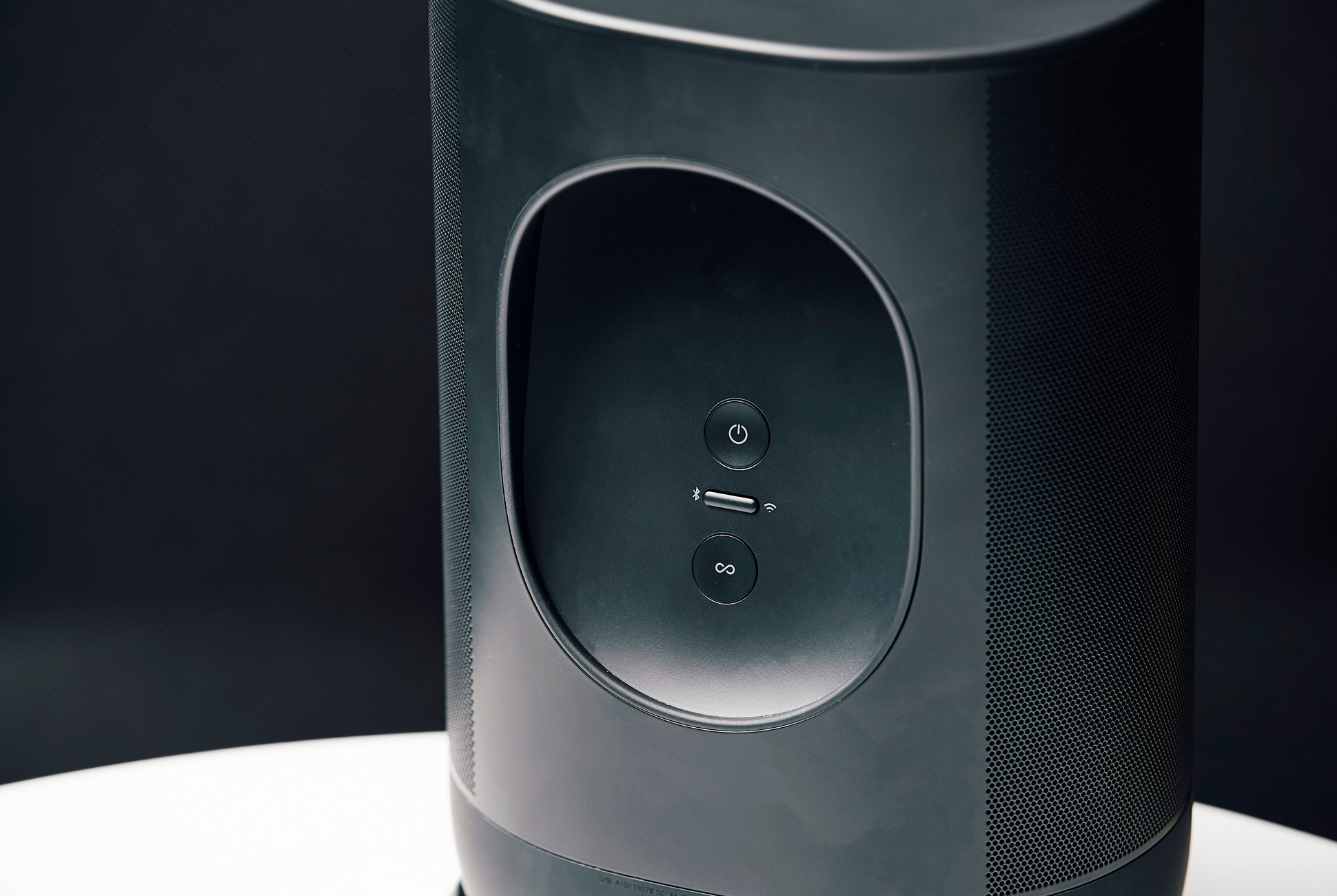
Instead of going through the app and waving your phone around (typical TruePlay behavior), the Move uses its built-in microphones and automatically tunes itself ever time you move it. It’s convenient and you can hear the difference. For example, when you move the Move from an open space to a closed-in space, like a media cabinet, you can hear the speaker lower its bass and crank up its mids and treble. All this happens in the space of a few seconds and, again, it requires nothing out of the listener (the microphones have to be on, though). Pretty cool.
When it’s not on its charging dock, or charging via USB-C, the Move has a ten-hour battery life – which is decent. That said, it has a pretty neat trick to save battery life. Anytime the speaker is not powered and it’s not playing music, meaning it could be in either Wi-Fi or Bluetooth modes, the Move will automatically turn off after a few minutes. According to Sonos, the Move can stay in this “Suspend mode” for up to five days before needing a visit back to the charger.
The biggest thing, at least for me, is that the Move doesn’t really complicate or change the Sonos experience. Because it’s the first Sonos speaker that has automatic TruePlay, it arguably makes the Move even easier to set up than other speakers. If there’s one caveat to this “Sonos experience,” it’s that the Move will automatically connect back to your home’s Wi-Fi when switching back from Bluetooth mode, but it won’t regroup with your other Sonos speakers. Basically, you’ll have to visit the Sonos app if you want to regroup your speakers after using the Move as a Bluetooth speaker. Not the end of the world, but something to watch out for.
Who It’s For: The Sonos Move won’t be for everybody. In fact, it’s a speaker with a hint of irony about it. Sonos designed it so that it could work for anybody in any situation – whether that’s indoors or outdoors, in your home or far from it – but it’s actually a speaker that’s optimal for a select few people. It’d be a great addition to somebody’s household who just wants a great-sounding speaker in every room of their house, but only wants to buy one speaker. If the person has a Sonos system and has an outdoor space (backyard or patio) that’s covered by Wi-Fi, then the Move would be a great way to extend your home’s sound outdoors. Finally, if the person is just a die-hard Sonos enthusiast, they really can’t go wrong with the Move.
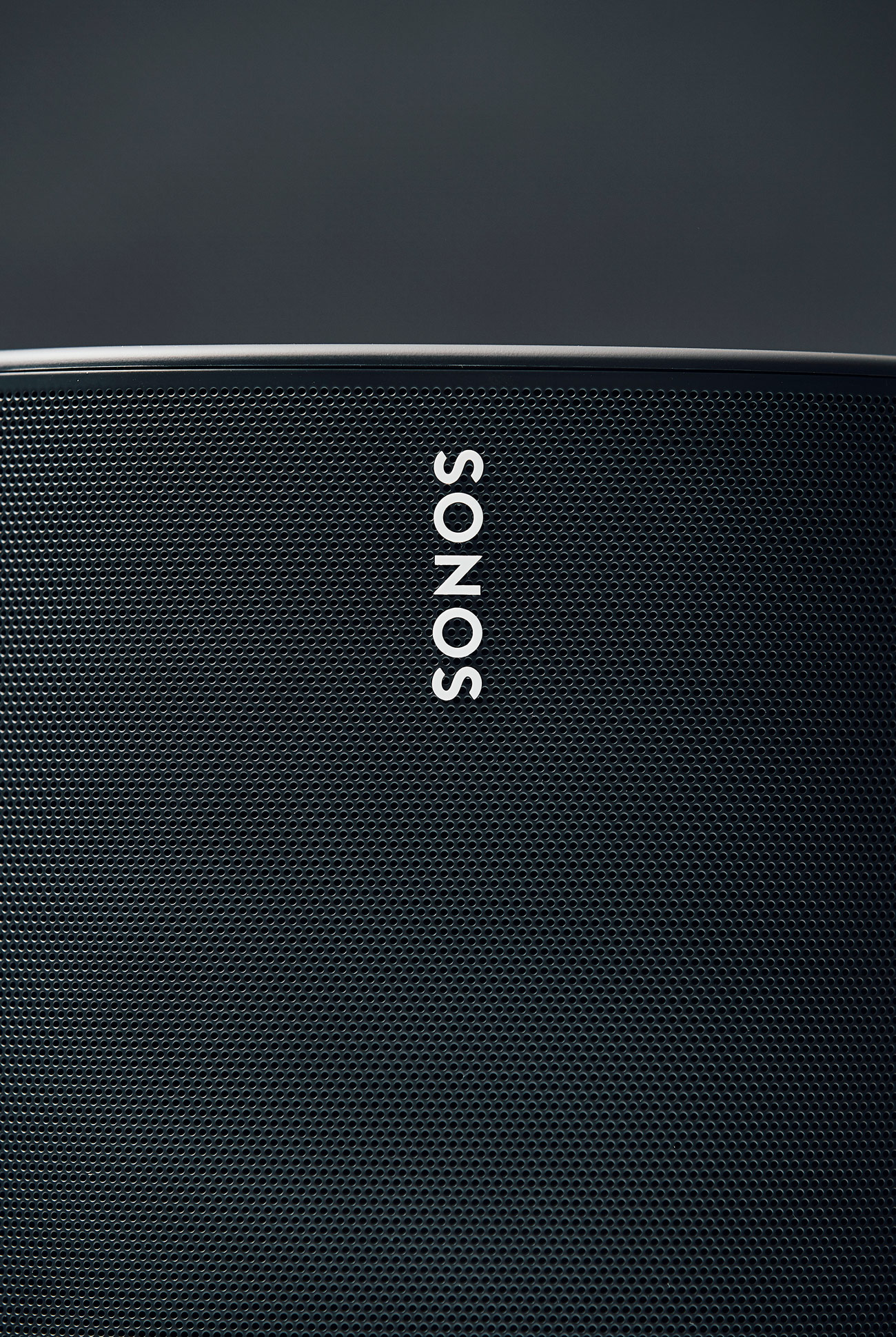
Watch Out For: The Sonos Move loses many of its best features when being used as a Bluetooth speaker. It can’t function as a smart speaker, so you can’t access Alexa or Google Assistant. Its automatic TruePlay doesn’t work, so it won’t sound as good as it possibly could. It’s can’t operate as a stereo pair with another Sonos Move (both speakers have to be connected to Wi-Fi for stereo pairing).
It’s also the first Sonos speaker that you’ll have to worry about replacing its battery (because it’s the only one to have a battery). Sonos claims that its battery should last roughly three years or 900 charges, but this will be an extra cost down the road; Sonos will sell the replaceable batteries, but they have yet to announce pricing. It’s worth noting that even if the Move’s battery does die, as long as it’s connected to power it will still function as a typical Sonos speaker.
At $399, the Sonos Move definitely feels expensive for what it is. It’s also not a small speaker and even though Sonos claims that it’s a great portable Bluetooth speaker (which I feel it definitely is), I have a hard time picturing many people lugging this 6-pound speaker to the beach.
Alternatives: As far as getting an entry-level Sonos speaker, you could buy two One ($199/ea) or two One SL ($179/ea) speakers, each of which has almost the same audio quality as the Move. If you don’t care about the versatility of the Move, just the audio quality, the Play:5 is a little bit more expensive and definitely is the superior-sounding speaker.
If you’re not committed to the Sonos ecosystem, there are plenty of alternatives. For instance, the UE Blast ($100) and UE Megablast ($170+), both of which are smart Wi-Fi speakers that work with Alexa and they are two of the best portable Bluetooth speakers, too.
It’s worth point out that Bose, arguably Sonos’s biggest speaker rival, recently released the Bose Portable Home Speaker ($349), which is a very similar speaker to the Sonos Move. The Bose Portable Home Speaker works with both Wi-Fi and Bluetooth, is compatible with Alexa and Google Assistant, and can be grouped with Bose’s other multi-room speaker.
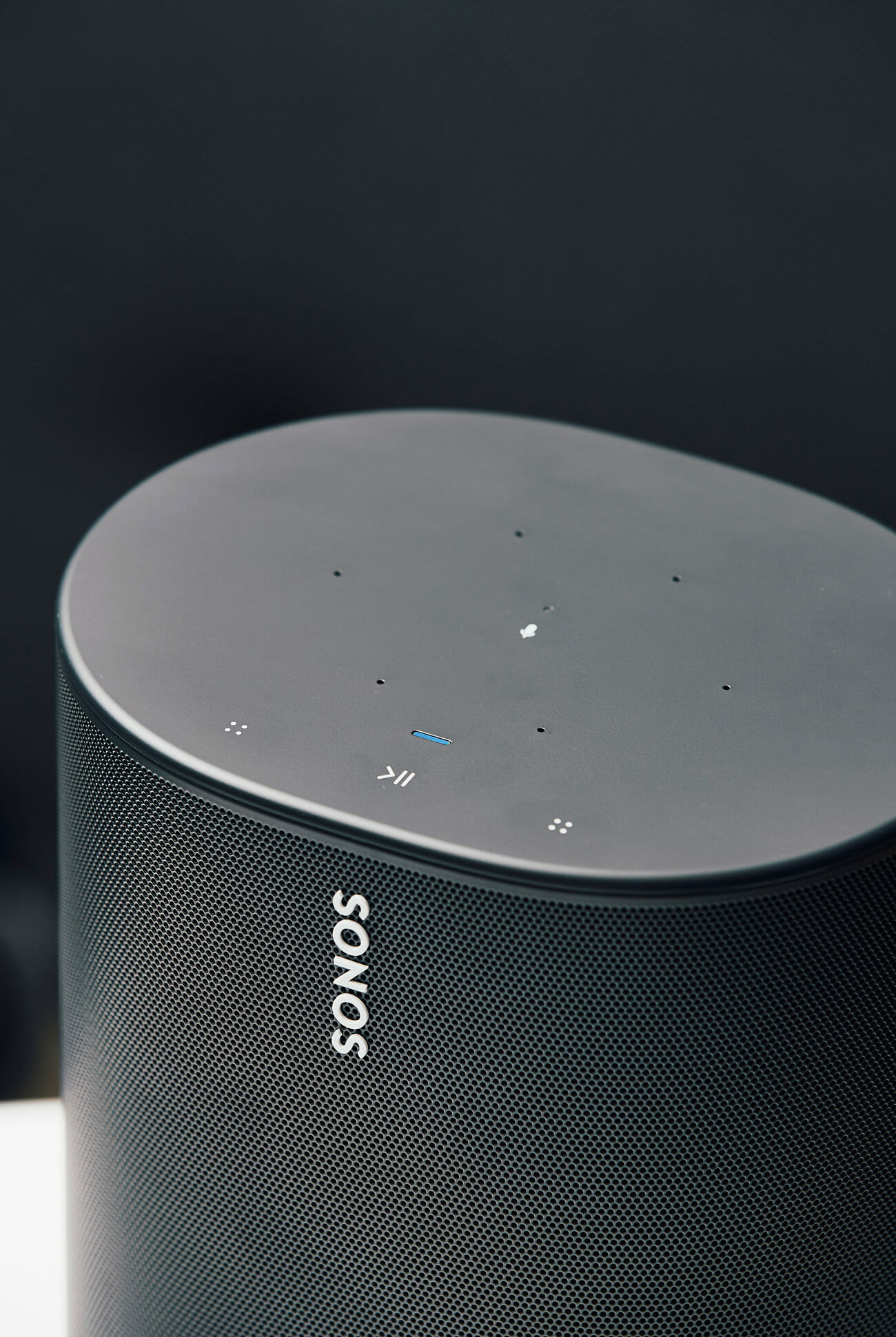
Verdict: The Sonos Move is a completely different kind of Sonos speaker, yet it still manages to feel…like a Sonos speaker. It sounds great, truly, and in some respects, it’s actually easier to set up and get playing than any other new Sonos speaker. That said, it feels a little expensive for what it is and unless you’re really going to take advantage of its versatility – take it from room to room, take it outdoors, and use it as true Bluetooth speaker – Sonos makes several other more affordable speakers that you’ll probably enjoy just as much.
What Others Are Saying:
• “For a lot of serious Sonos fans, the Move will be a no-brainer. Folks have been wondering for years when Sonos will make the jump to Bluetooth and make its famously exceptional multi-room wireless speaker systems more versatile. A lot of those people have invested hundreds if not thousands of dollars into their Sonos systems, and the idea of adding one more—one that has Bluetooth, that can go anywhere—is exciting. The Move sounds like a Sonos speaker. It works with all the other Sonos speakers. Sure, a Sonos diehard will love this thing. The average consumer just looking for a portable speaker, however, might not be so enthusiastic.” — Adam Clark Estes, Gizmodo
• “The Move also cannot connect to multiple phones or devices at a time either, so you only get to have one DJ at your party. Oh, and though Sonos is known for its ability to group multiple speakers into ad-hoc zones, this isn’t possible on Bluetooth. And that’s despite many competing speakers, like that Megaboom we keep mentioning, having the ability to daisy-chain together. For now, it’s clear that Sonos still sees Bluetooth as an add-on, not a core focus. Sonos could add more Bluetooth features in the future via app updates (something it does frequently), but the company’s heart still lies with Wi-Fi..” — Jeffrey Van Camp, Wired
• “The biggest question that most people seem to have about the Move is about whether it’s worth the nearly $400 price tag. Frankly, it’s a tough price to swallow for what largely amounts to a $200 Sonos One with a battery bolted to the bottom of it. It’s also a lot more money than the typical Bluetooth speaker costs. But the Move also does things that no other Sonos speaker nor any other Bluetooth speaker can do, and it does it all without compromising on sound quality, volume, or features.” — Chris Welch, The Verge
Drivers: One downward-firing tweeter, one mid-woofer; two Class-D digital amplifiers
Connectivity: Wi-Fi, Bluetooth, AirPlay 2
Battery: up to 10 hours
Water Resistance: IP56 rating
Weight: 6.6 pounds
Sonos provided this product for review.


Whether you’re talking about smarthome speakers, multiroom audio or TV soundbars, there’s no denying that Sonos makes some of the most stylish and advanced audio options on the market. The one thing the brand was…
It’s exciting times for Sonos. The multi-room speaker giant just announced three new products at IFA, Europe’s biggest consumer tech trade show. There’s the Sonos Move, the company’s first-ever portable speaker; the Sonos Port, which is the next-generation version of the Sonos Connect; and there’s the Sonos One SL, a new entry-level Sonos speaker. We’ve given you a brief rundown on all three new products below.
The push for new products shouldn’t be a surprise if you’ve followed Sonos. Patrick Spence, the company’s CEO since 2017, is actively moving the company to be more open and forward-thinking, as well as pushing it to expand its product line. Since Spence took over, Sonos has released its first smart speaker, partnered with IKEA to make the most affordable Sonos speakers (Symfonisk), and now it has entered a completely new market: portable audio.
The Sonos Move is the company’s first-ever portable speaker. It has built-in Wi-Fi and Bluetooth, allowing it to be way more versatile than any other Sonos speaker to date; you can use it like a Sonos One smart speaker – yes, the Move can be integrated with either Alexa or Google Assistant – or you can use it as a portable rugged Bluetooth speaker. There’s a new three-button array on the back of the speaker that allows you to toggle between modes. The Sonos Move costs $399 and is available for preorder now; you’ll be able to pick it up in stores or buy online on September 24.
The Sonos Port is the next-gen Connect ($349) you’ve been waiting for. It works the same way, hooking up to your existing stereo or receiver and turning your non-Sonos sound system into one that works just like it, but the Port adds some big things. First, it supports AirPlay 2. Second, it has 12-volt trigger, which enables the Port to automatically turn on your connected receiver when signaled through the Sonos app. And third, it’s matte black and actually looks like it will blend in with your other stereo components. The Sonos Port costs $399 and is available for preorder. A select number of models will starting on September 12, but they’ll be available everywhere starting in January 2020.
The Sonos One SL is essentially a Sonos One speaker without the built-in mics that allow you to talk to Alexa or Google Assistant. Or you can think of it as a Play:1 speaker but in the body of a Sonos One. Either way, the Sonos One SL is the company’s new most entry-level speaker – aside from the Ikea x Sonos Symfonisk speakers – and it costs $179. It’s available for pre-order right now in either white or black. Sadly, the introduction of the Sonos One SL means that Sonos will be phasing out its original Play:1 speaker.

Just when you thought Ikea’s offerings largely amounted to assembly-required furniture designed to challenge you even when you’re sober, they’ve revealed a new product born from their partnership with audio product manufacturer Sonos in the…
The speakers you can install on walls and ceilings Sonos and Sonance talked about in August last year are finally here. The Sonos Architectural is a series of passive speakers you can integrate directly into your living space.
There are three: an in-wall, an in-ceiling, and a standalone weatherproof outdoor speaker. Each can work with the Sonos Amp for built-in whole-home streaming audio.
Let’s get into the outdoor speaker first. Expressly built for Sonos, this features a weatherproof design for year-round listening parties outside the home. Don’t worry about leaving it outside. Sonos designed it to withstand humidity, heat, water, salt spray, UV rays, and freezing temperatures.
As for the in-wall and in-ceiling options, they come with a number of differently shaped grilles. That’s so you can install them into your desired spots without them ever standing out like a sore thumb. They’re called “Architectural” after all, so they’re meant to blend well with the space, not disrupt it. You can automatically tune the speakers to the room using Sonos Trueplay to get optimal sound.
Once installed, the speakers work just like any other regular ones. But there’s a number of notable extra here apart from the premium sound quality typical of Sonos speakers. You’re looking at AirPlay 2 support, Sonos app integration, and hundreds of compatible streaming services at the ready. Spotify, Apple Music, and Amazon Music are just the tip of the iceberg.
Sonos says you can pair up to three Architectural speakers with a single Sonos Amp. Prepare to invest in a few of these amps if you’re planning to customize more than one room.
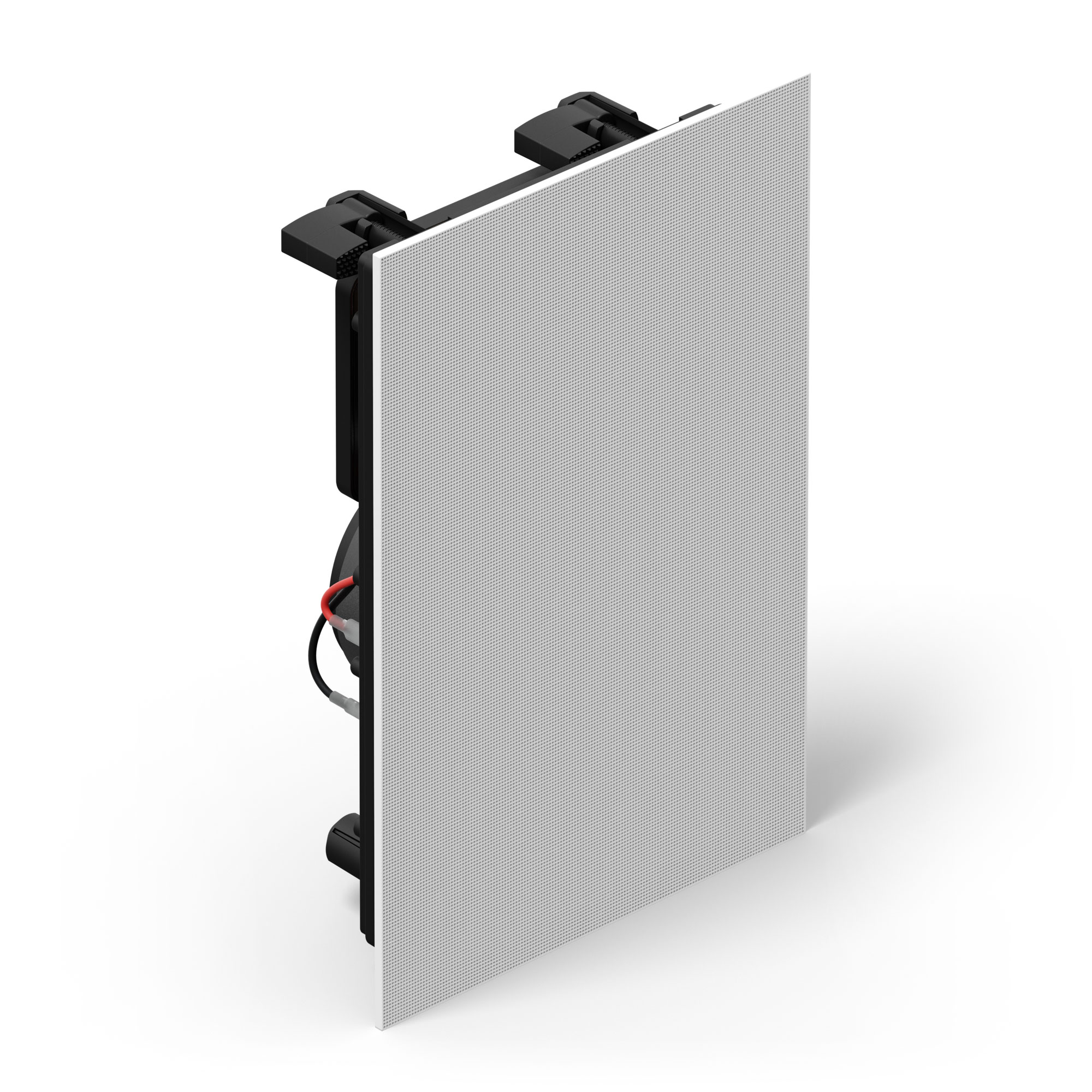
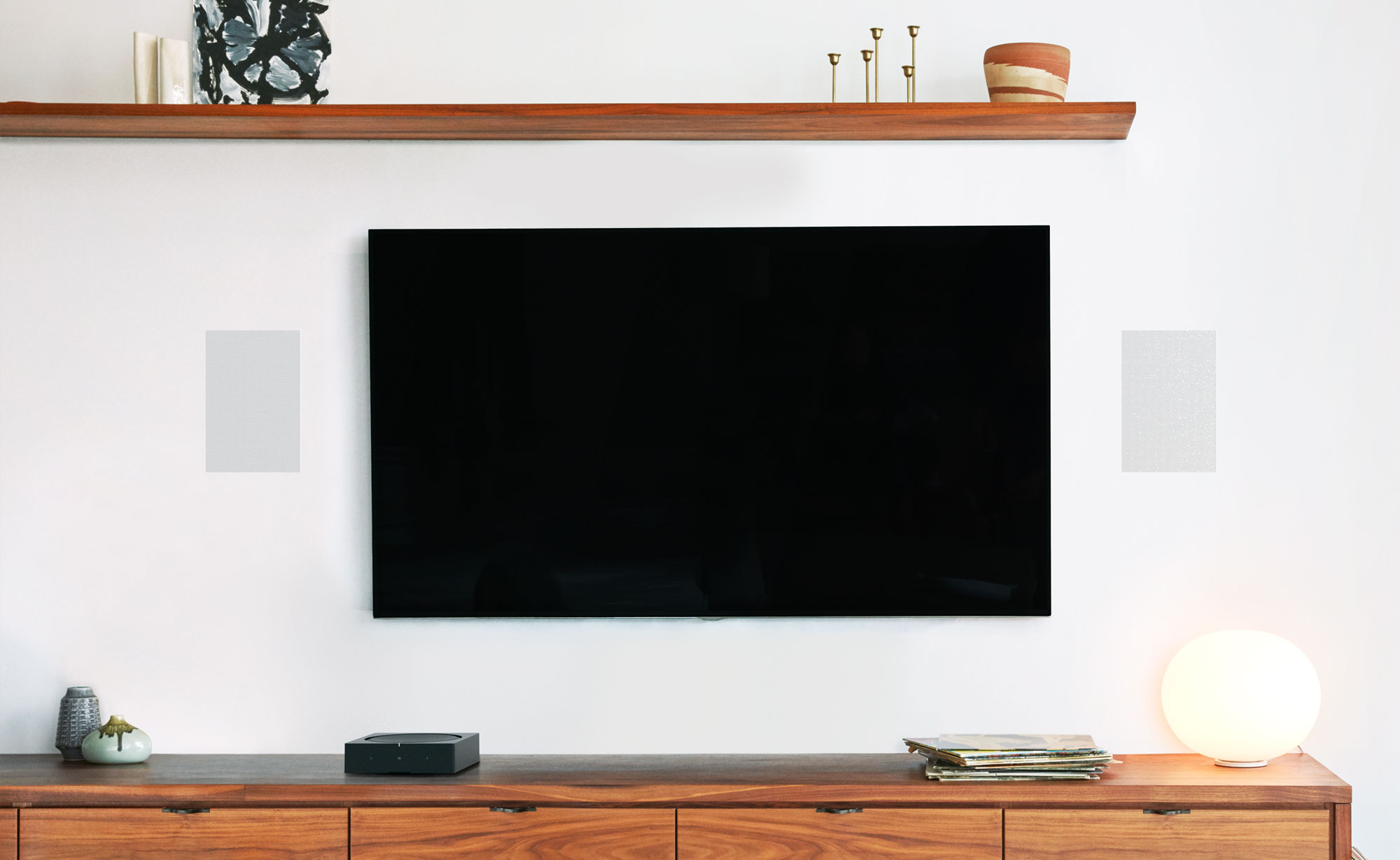

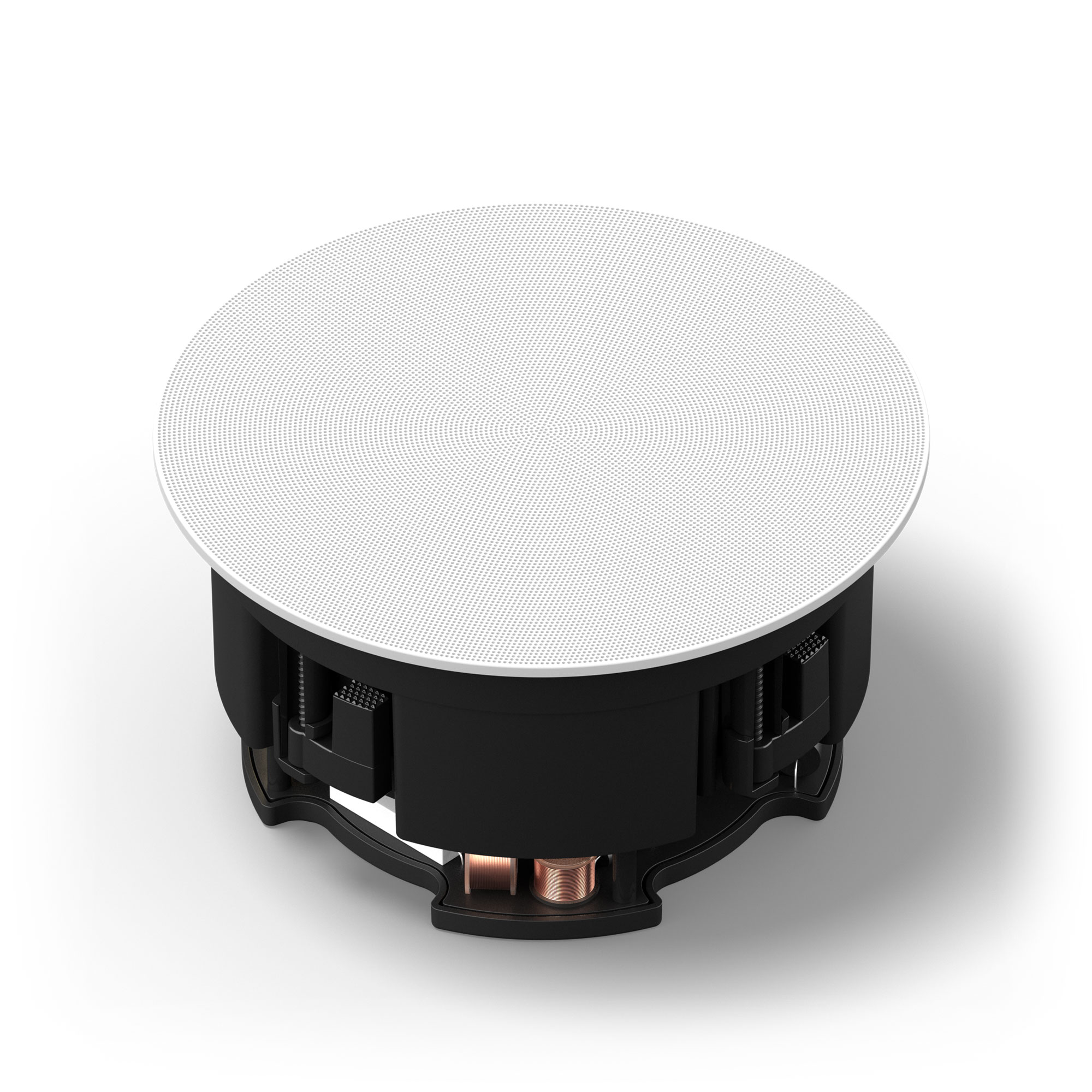
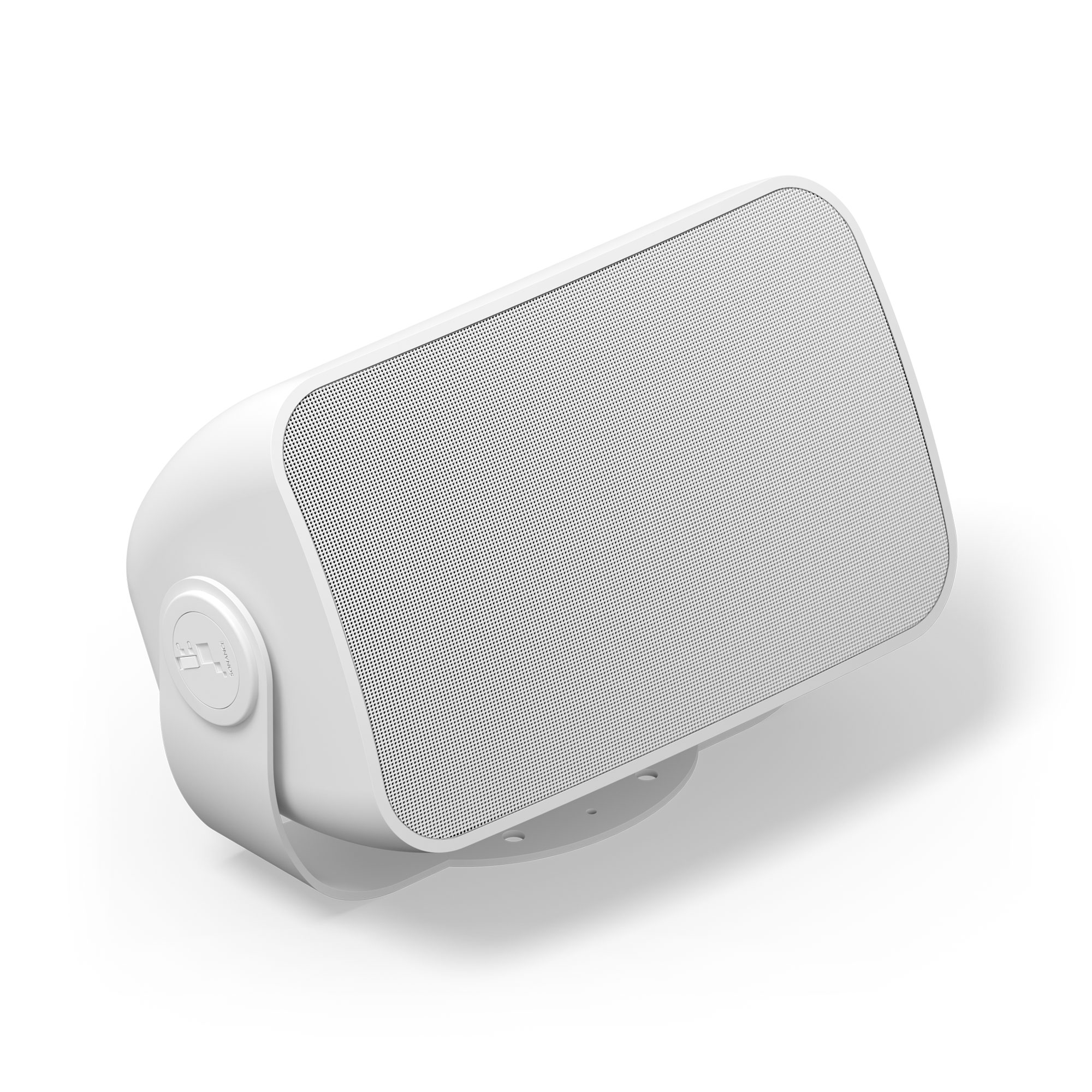
Photos courtesy of Sonos
The Sonos Beam ($399) is the company’s newest soundbar that, similar to the Playbase ($699) and the Playbar ($699) that came before it, integrates your TV with your existing Sonos speakers. If you have a multi-room setup you can play the TV’s audio throughout your whole house, or you can configure your other Sonos speakers as satellites and/or rear channels and thus have a complete Sonos surround sound system.
That said, the Sonos Beam is much more than a smaller, more affordable version of those other soundbars. It’s a smart speaker with Alexa built-in, like the Sonos One, so you can ask Alexa to play music or control your smart home devices. And since it’s connected to your TV, you can use your voice to control your TV, too, which is a first for Sonos. For TV control, the Sonos Beam will work best for those with an Amazon Fire TV (or a TV with an Amazon Fire TV dongle), allowing you to ask Alexa to turn on the TV and even go to specific shows or channels. Also, unlike Sonos’s larger soundbars, the Sonos Beam can be either wall mounted or left to rest on your media console. (The Playbase needs to rest under your TV while the Playbar is designed to be wall mounted.)
|
The Good: The great thing about any Sonos speaker, other than its sound quality, is that it comes with great software and an intuitive companion app — and the Sonos Beam is no different. You just plug the soundbar in, and then the app walks you through how to correctly connect it to your TV. The app also tunes the soundbar so that it’s optimized for your room, using its Trueplay tuning software, same as other Sonos speakers. If you own an Amazon Fire TV (or dongle), the Sonos Beam will be able to control your television almost completely. It plugs into to your TV through HDMI ARC port and it supports CEC, so you can use your TV’s remote to adjust the volume if you don’t feel like asking Alexa.
One of the most intriguing aspects of the Sonos Beam is that Sonos promises that it will eventually support all major virtual assistants, including Alexa (built-in), Siri (mid-July) and Google Assistant (by end of 2018). Not only that, but the Sonos Beam promises “cross-platform voice control,” meaning, as it pertains to music streaming, you’ll be able to ask Siri to play a song, then ask Alexa what song was playing. (This is an example that Antoine Leblond, Sonos’s VP of software, showed off at the Sonos Beam’s launch event in early June). You’ll be able to do other things like this eventually, but the conditions need to be perfect for it to work — certain virtual assistants won’t work with certain streaming services, for example. These cross-platform voice controls aren’t available at launch, so I wasn’t able to test them, but knowing they’re coming is a good thing. (It makes the product “future proof.”)
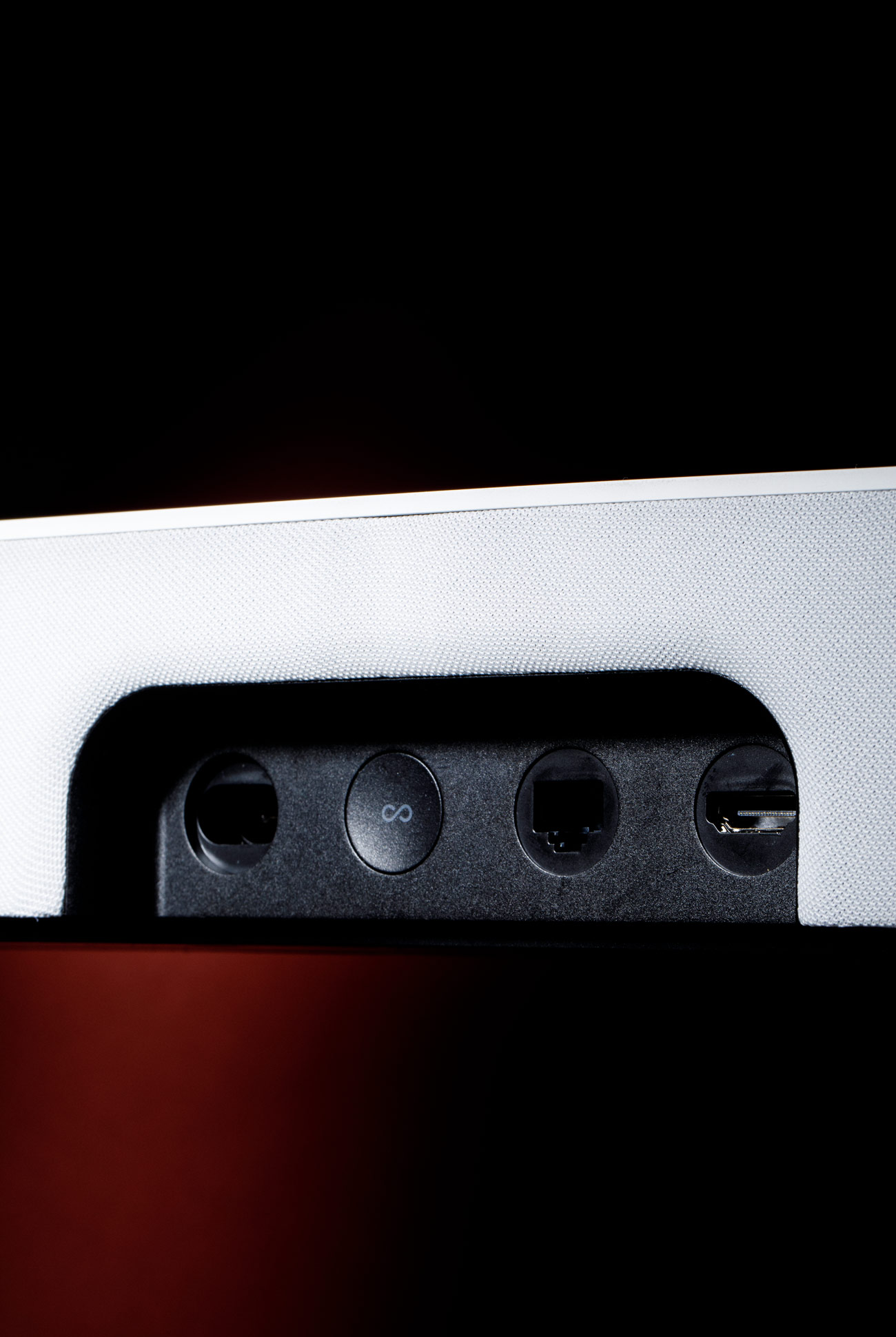
Who They’re For: At launch, there are two ways of looking at the Sonos Beam. Either 1. you’re buying it because you have other Sonos speakers and you want to integrate your TV into the mix, or 2. you want one smart speaker to rule your home — it can greatly improve the sound of your TV while also being a darn good speaker for streaming music. In the latter instance, the Sonos Beam is effectively taking the place of any quality sounding smart speaker, like the Google Home Max or Apple’s HomePod.
Watch Out For: The Sonos Beam is a plug-and-play, entry-level speaker that’s designed to work well with other Sonos speakers, but if you have a home entertainment system that includes an A/V receiver and non-Sonos satellite speakers, this is probably not the soundbar for you. (You could integrate them all with a Sonos Connect:AMP, but that gets messy and expensive.) If you don’t have an Amazon Fire TV, you won’t be able to control your TV with Alexa as completely as you might expect. And if you use your TV’s optical port instead its HDMI-ARC port, you won’t be able to turn the TV completely on/off with Alexa. Even though the Sonos Beam sounds very good with its wide stereo separation, it won’t sound as immersive as other soundbars with Dolby Atmos or DTS Virtual:X that creates three-dimensional sound using virtual height channels.
Alternatives: The Playbar ($699) and Playbase ($699) are the two other soundbars that Sonos makes. Both are louder than Sound Beam and probably better options for larger rooms. The main difference, other than size and cost, is that neither of those soundbars is a smart speaker that’s integrated with a virtual assistant: you can’t summon music or you control your TV (in any capacity) with your voice.
If you’re just looking for a soundbar that doesn’t need to sync with other Sonos speakers around the house, there are a number of great-sounding and more affordable options to choose from; the Yamaha YAS-207 ($300), for example, is affordable and supports the latest surround sound technologies by DTS and Dolby Audio.
Review: For the last week I’ve had the Sonos Beam hooked up to my Vizio M-Series (2017 model) and I can tell you, right off the bat, that the Sonos Beam won’t be for everybody. If you have an A/V receiver and two satellite speakers that are normally connected to your television, like me, you’re not going to be able to easily integrate the Sonos Beam into your home theater without a Connect:AMP, which is expensive. I didn’t have one, so I reviewed the Sonos Beam as a standalone soundbar. That said, you’re not going to buy the Sonos Beam to integrate it into your non-Sonos home theater system. It’s a soundbar that’s meant to work by itself or with other Sonos speakers. And that’s what it’s great at.
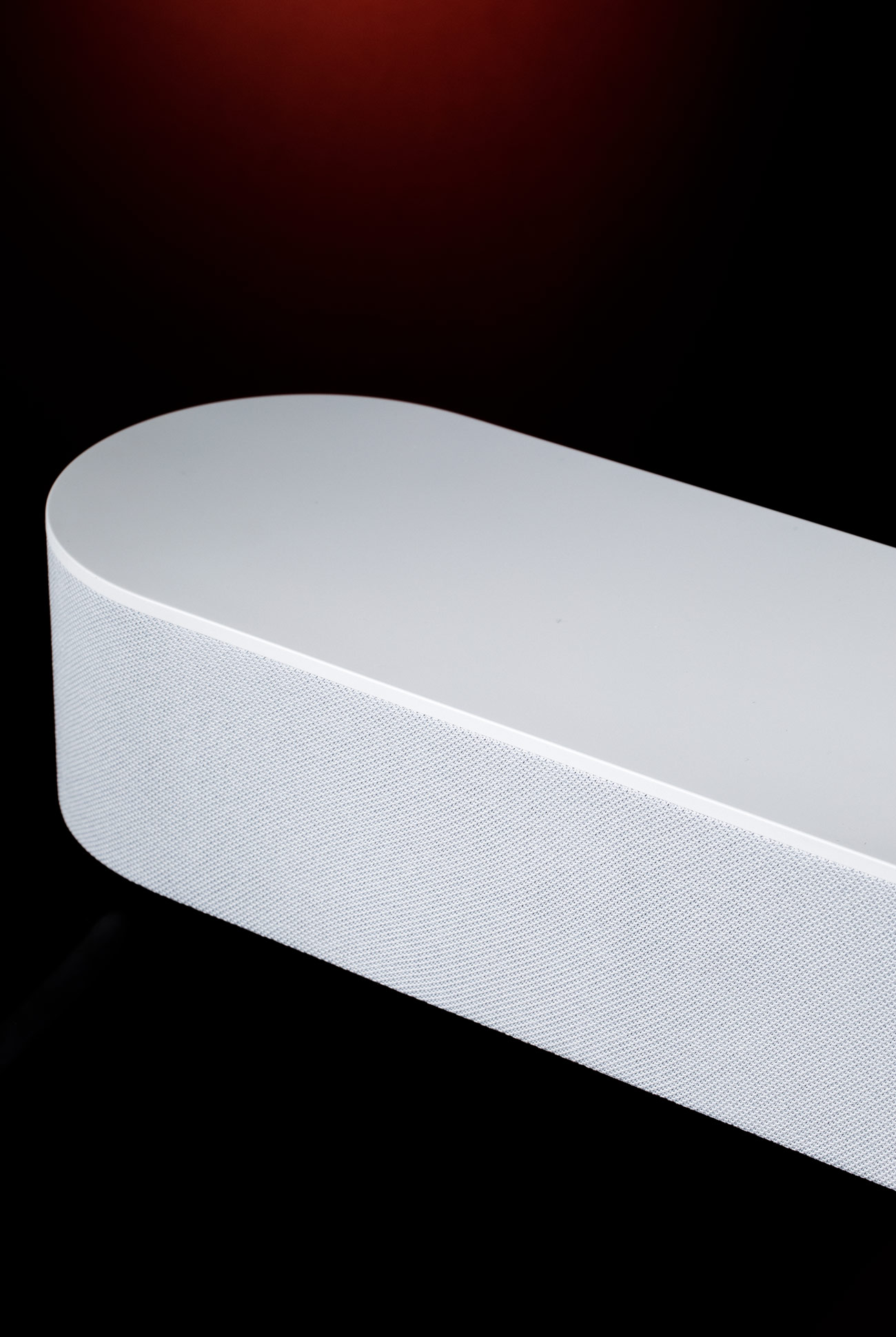
The Sonos Beam is a 3.0-channel soundbar that can be integrated into 5.1 surround sound system if you add two Sonos One (or two Play:1) speakers and a Sonos Sub. However, I’m guessing that most people looking at the Sonos Beam aren’t going to have those other Sonos speakers — yet — and are instead just looking at it as a great-sounding, versatile and entry-level soundbar. It sounds very good, with a wide stereo separation that isn’t as immersive as other immersive technologies (like Dolby Atmos or DTS Virtual:X), but still makes you feel like in the movie or show (especially if you’re watching in a small-to-medium-sized room). Using the soundbar is exactly like talking to an Amazon Echo or a Sonos One speaker. You can select from the same default music streaming services (Amazon Music, Spotify, Pandora), but the Sonos Beam just sounds bigger and better than those other smart speakers.
The other difference is that the Sonos Beam is obviously a big upgrade over your television’s speakers. When you turn on the television, the sound comes out of the soundbar and movie nights or just watching ESPN become instantly better. Worried about a tedious setup process? Don’t be. The Sonos app walks you through the whole thing, from using an optical dongle if your older TV doesn’t have an HDMI output for audio, to turn off your TV’s default speakers — it’s all really easy.
Again, the Sonos Beam excels as a soundbar and as a smart speaker. The last thing that Sonos Beam can do is control your television, and this is where it gets a little iffy. If you have an Amazon Fire TV (or dongle), it works wonderfully. In a private demo, I witnessed the Sonos Beam turn the television on and off, open up to specific shows, and pause and rewind those shows. Boom. Amazing.
I don’t have an Amazon Fire TV, though. I have an Apple TV 4K and an Xbox One, both of which are connected to the TV in my room, and I wasn’t able to utilize many Alexa commands. I was able to adjust its volume and I was also able to switch to specific channels and programs (like ESPN’s “Get Up” show in the morning) on the TV that’s in our living room, which is where our Verizon Fios cable box is connected. So if you don’t have an Amazon Fire TV, but your Sonos Beam is connected to a TV with a cable box (Sonos supports all the major providers), you’ll be able to ask Alexa to go to specific channels. But you still won’t be able to open apps on the Apple TV, like HBO Now or Netflix, until support for Airplay 2 launches in the coming weeks.
(Note: When support for Airplay 2 launches this July, anybody with an Apple TV will be able to ask Siri to play specific apps and shows. You’ll have to speak to Siri directly through your iOS device or Apple TV remote, however, and not directly through Sonos Beam like you can now with Alexa.)
Verdict: The Sonos Beam promises a lot, especially when it comes to cross-compatibility. If it’s actually able to understand and work with Alexa, Siri and Google Assistant, all at the same time, then that’s great. Better than great, actually. But I wasn’t able to test that and in my experience, when virtual assistants from one company start controlling devices from a different company, things get complicated and they never work as well as you think they should. (Siri still won’t be able to identify a song playing on Spotify, for example.)
Sonos is known for not being complicated, however. You just plug in its speakers, follow the in-app instructions and they just work. So instead of looking the Sonos Beam as this ambitious speaker for the home, even though it could turn out to be just that, I think it’s better to look at what you’re guaranteed to get out of it. And that’s an audiophile-grade smart speaker, rivaling the Google Home Max or an Apple HomePod, and that’s a terrific entry-level soundbar. Throw in the fact that it’s going to be able to work with most future smart devices, and $399 is a pretty good deal. If you have an Amazon Fire TV, it’s a steal.
What Others Are Saying:
• “At a high level, all of this means that the Sonos Beam will offer an exchange between competing voice assistants in a way that no other smart speaker on the market does. But to Jones’ point, there are still limitations around how all of that will work, due to the way the individual cloud services work. While I was at the company’s offices, Sonos more than once used an example where you’re using Siri to initiate a song and then asking Alexa to identify which song it is. In reality, that will work only if you’re playing Apple Music. Switch to Spotify and Siri can’t be used for song search or initiation, only playback and volume controls.” — Lauren Goode, Wired
• “At $399, the Beam isn’t cheap, but it’s markedly less expensive than Sonos’ other TV speakers. It’s the same price as the Google Home Max and only $50 more than Apple’s HomePod. But because it also works as a soundbar, it offers more utility than either of them. And because Sonos is trying to mediate between all these different ecosystems, it works (often better) with more services than either of them.” — Dieter Bohn, The Verge
Drivers: four full-range woofers, one tweeter, three passive radiators
Channels: 3.0
Key features: five-microphone array,
Compatibility: Amazon Alexa, Siri/AirPlay 2 (July), Google Assistant (sometime in 2018)
|
Hot takes and in-depth reviews on noteworthy, relevant and interesting products. Read the Story